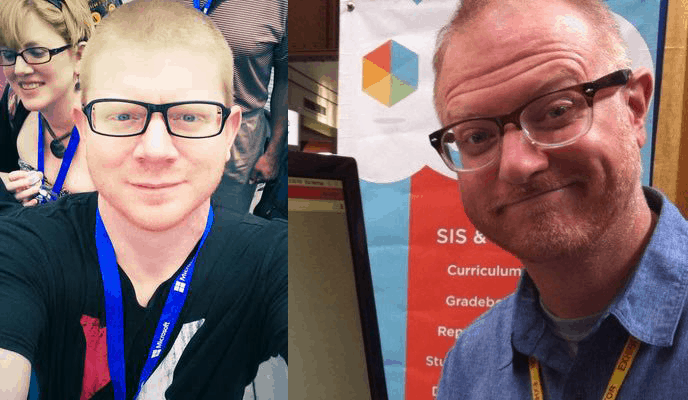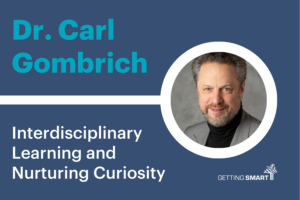Time for an Honest Conversation About Confronting Change

Eric Nentrup (EN) is a former teacher and now Alma’s Director of K12 Solutions, Eastern US. Eric lives in Indianapolis, IN.
Moss Pike (MP) teaches Latin at Harvard-Westlake School in Los Angeles, CA.
EN: Since leaving the classroom to work for Alma, one of the GettingSmart.com Next-Gen Learning Platforms, I’ve learned a lot about the complexity of decisions that are made to serve an entire school system. I have had my eyes opened to the amount of valuable time that is invested in not only the purchase of successful implementations of instructional technology. This goes beyond the cost of the tool(s) itself. Everything from hundreds of hours school leaders spend scouting, researching, and evaluating options in the market, to on-site consultation or training, to hard training materials, to the not insignificant amounts of time invested by the district employees in order to deeply understand the scope of needs for a given learning community and how to approach those needs. Have you experienced anything like this in your school or district?
MP: A few years ago, as we prepared to launch our 1:1 laptop program, we made the decision to adopt a new LMS and were thus presented with a number of choices to make, including not only the platform itself, but how we planned to integrate the LMS into our school systems. After considering our options, we chose Instructure’s Canvas LMS and named it the “Hub,” given that we wanted it to be the central storage place for housing all of our other digital tools. As has been the case with other LMS adoptions (cf. the Palo Alto’s adoption of Schoology), however, the decision to require all faculty to manage a digital presence on the Hub including homework and other resources was met with some dissent.
EN: You mention the dissent or resistance that you encounter. I have to believe that’s a natural reaction to any “top down” mandates. Any enterprise-grade technology decision is very likely going to be a top-down decision, though, right? It doesn’t matter if it’s a rural New England supervisory union of 500 kids or a bustling suburban district with more than 75,000. One of the most expensive costs of any enterprise-grade shift to something like a new SIS or LMS is the amount of time dedicated to determining need and choosing the solution from a litany of choices. Only then implementing the solution well enough to address the initial problems that were first identified.
MP: That was indeed the case. Many of our faculty feared that we were imposing a new way of teaching that required too much work to maintain or that the technology wasn’t necessarily better for students. We certainly experienced the tension you mention in balancing the desire to make use of new digital tools and alternative forms of pedagogy with the necessity of investing the time for training our faculty to use the Hub and for them to perform daily course maintenance on it. In hindsight, the resistance isn’t at all surprising or difficult to understand.
EN: It seems that there is an inherent tension created when such a suggestion is made. As such, more often than not, nothing changes because it seems too challenging. Do you think that there is an underlying reason for this phenomenon? Considering that we expect our students to be in a constant state of change from K all the way through 12, isn’t it a bit of a double standard if we don’t model change or growth as adults? We have to eat our own dog food, right?
MP: Fear is usually cited as the reason why change happens slowly, if at all, and that word was found no shortage of use when we moved toward the Hub. While there’s much truth to this, it’s not the full story, and in my experience, telling people not to be afraid only serves to inspire even more fear. What I think is going on is our overweighting of the current ways of doing things. This phenomenon has become a well-known tenet of the field of behavioral economics and was popularized, in particular, by Richard Thaler (see his book Misbehaving: The Making of Behavioral Economics) and Daniel Kahneman (cf. Tom Vander Ark’s review of Thinking, Fast and Slow). Basically, we tend to value something more if we own it than if we don’t, and I think this phenomenon, without doubt, includes our beliefs about education.
EN: I get the fear of change, but like anything else think there’s a skill you can overcome there. But you’re talking about the very basic human hunting/gathering trait of “loss aversion”, right? And whether on the inside as a teacher, or now on the outside working with hundreds of districts across multiple states, it always manifests itself as “the devil you know…”
That said, I’m really encouraged by the chemistry I see in school leaders where there is an ease of dialogue, a transparency about what works and doesn’t work, and a sort of common openness to sharing their vision for serving their teachers, their kids, and their families well. Those conversations are really exciting. These teams harken to what Bennis called “great groups” in his classic, “Organizing Genius.” These adults seem a bit less prone to the trappings of these behaviors. Still, further down, like at the school front desk or even in the classrooms, there may be some tension to manage that could be related to what you say about Thaler and Kahneman. Is that the so-called endowment effect kicking in?
MP: Yes, I think so. It’s what Kahneman calls “System 1” thinking or our snap judgments that we cling to, when presented with new and potentially challenging decisions to make. The endowment effect is what then creates a tension toward change, when we overvalue what has worked well for us in the past, leading us to thus undervalue the potential change and ignore any opportunity costs. If writing homework on the board or passing out a weekly homework sheet each Monday has worked well for me in the past, for example, it must be effective, and so why should I do something different that takes more of my time and effort?
EN: Precisely. But with all the Twitter chat PLNs, more widespread wifi and cheaper technology afforded to the current practicing teacher, you’d have to be pretty isolated to not have the routine challenged, wouldn’t you?
MP: More educators than we think are isolated, I fear. My own bias to social media has led me to overestimate the number of educators who use it, at least those educators who are in the position to make decisions with far-ranging implications for a given community.
I’m wondering, Eric, if you can say a little more about the successful implementations of educational technology that you’ve seen. What has worked, and can you identify any common threads in successful implementation? What does it take to push us past the fear, or rather, to negate the endowment effect of tradition?
EN: The best implementations I’ve seen have steered clear of the “panacea” or “magic bullet” trappings. I can think of both software and hardware purchases that seemed too good to be true to a few people, but hadn’t been arrived at by consensus. When you’re on the receiving end of that type of a decision, it’s like waking up in the morning and seeing a bunch of different clothes in your closet than were there the day before. They may not fit well. They may not be a style you’d choose for your tastes. But you have to wear them.
Though evaluation of all the complex factors is necessary, like budget, understanding the current political climate and morale of your school and district, etc., the best thing to do is to understand theoretically what problem you’re trying to solve. You have to know this problem well, be relaxed and comfortable with it and have an approach to mocking up a possible solution for it.
 I’d have to defer to my design-thinking comrades who’ve held their teams to the process for arriving at a composite solution that suits their needs before comparing that model to what’s available on the market, whether it’s an SIS an LMS, or even a curriculum package of some sort. And if that framework is too ethereal, The Blended Learning Implementation Guide is a very practical approach that harmonizes.
I’d have to defer to my design-thinking comrades who’ve held their teams to the process for arriving at a composite solution that suits their needs before comparing that model to what’s available on the market, whether it’s an SIS an LMS, or even a curriculum package of some sort. And if that framework is too ethereal, The Blended Learning Implementation Guide is a very practical approach that harmonizes.
MP: Very true, and I’m in complete agreement that we must understand the problems we’re trying to solve, before making these kinds of decisions. In what ways do your design comrades look at problems to help them arrive at a better understanding of the challenges they face by moving away from bias and the endowment effect?
EN: What I’ve learned is that we most often go shopping for “our type”. Questions I face regularly could best be analogized by the Henry Ford quip:
“If I had asked people what they wanted, they would have said faster horses.”
So, while I’m explaining a concept for a different mode of transportation altogether, they’re asking the equivalent of:
- So. How long are the legs on your horse?
- Your horse has all four legs, right?
- Where’s the tail? I don’t see the tail.
- Where do the oats go in? And how often do you have to clean the stall?
- Can you include unlimited free saddle blankets?
If instead they were focused upon the need to get from A to B efficiently, safely, and to do so with less time and money invested in maintenance and upkeep, not to mention capacity to take more along for the ride, we’d be having a much more substantial conversation.
Beyond that, the people involved have ownership in the decision and will shoulder the implementation alongside the decision-makers. This is actually more critical than having a loaded war chest of technology funding.
MP: So, are the problems are structural, at least in part? In other words, do the administrative systems we’ve created that give way to the kinds of top-down decisions you mentioned above allow educators to take as much ownership in a particular decision as they’d like to have?
EN: Great question. It’s a lot easier to see the differences between old and new methods at the classroom level. I think the conversation about how organizational leadership of the entire school system — even a relatively smallish one of say, less than 5,000 students — is just one more component that needs to be reimagined.
Also, I think the #FutureReady superintendents are eager to do that. In my conversations with such leaders, empowering teachers to serve students well is truly the focus of their strategy. However, the larger the district, the more distanced from that connective tissue the central office leaders can become. Smaller learning communities, flatter org charts, and a repositioning of the teacher voice will either drive that or be the hallmarks of such change in my opinion. That can yield more collaborative results of even district-wide purchasing decisions, and shared ownership, of course. Speaking of such districts, Thomas Murray, spokesman for the Future Ready campaign, along with Eric Sheninger and other digital leadership experts recently co-wrote a white paper to help small to mid-size districts make the case for change.
So, bringing this conversation to a solid pause for opening it up to others for their thoughts, I’ll conclude by saying this: I think any big decision can be co-owned as long as the needs the solution are addressing themselves were arrived at in consensus. The endowment effect can be mitigated. We are essentially shifting “ownership” from an element in an individual educator’s status quo to the desire for something more valuable in their practice.
I’d like to think such work makes even the process of change — even wholistic change for an entire school system — actually enjoyable in and of itself.
For more check out:
- The Procurement Tightrope Shouldn’t Tie Districts in Knots
- Smart Series Guide To EdTech Procurement
- How to Make the Case for Technology Change in Small to Midsize Districts
Stay in-the-know with all things EdTech and innovations in learning by signing up to receive the weekly Smart Update.







0 Comments
Leave a Comment
Your email address will not be published. All fields are required.